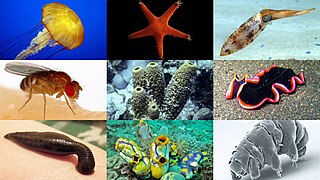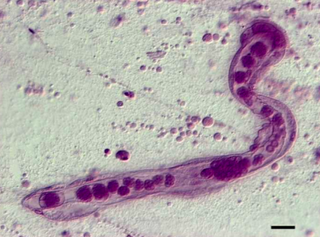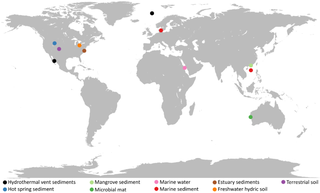
Invertebrates is an umbrella term describing animals that neither develop nor retain a vertebral column, which evolved from the notochord. It is a paraphyletic grouping including all animals excluding the chordate subphylum Vertebrata, i.e. vertebrates. Well-known phyla of invertebrates include arthropods, mollusks, annelids, echinoderms, flatworms, cnidarians and sponges.

The Chaetognatha or chaetognaths are a phylum of predatory marine worms that are a major component of plankton worldwide. Commonly known as arrow worms, they are mostly nektonic; however about 20% of the known species are benthic, and can attach to algae and rocks. They are found in all marine waters, from surface tropical waters and shallow tide pools to the deep sea and polar regions. Most chaetognaths are transparent and are torpedo shaped, but some deep-sea species are orange. They range in size from 2 to 120 millimetres.

The Mesozoa are minuscule, worm-like parasites of marine invertebrates. Generally, these tiny, elusive creatures consist of a somatoderm of ciliated cells surrounding one or more reproductive cells.

Nemertea is a phylum of animals also known as ribbon worms or proboscis worms, consisting of 1300 known species. Most ribbon worms are very slim, usually only a few millimeters wide, although a few have relatively short but wide bodies. Many have patterns of yellow, orange, red and green coloration. The foregut, stomach and intestine run a little below the midline of the body, the anus is at the tip of the tail, and the mouth is under the front. A little above the gut is the rhynchocoel, a cavity which mostly runs above the midline and ends a little short of the rear of the body. All species have a proboscis which lies in the rhynchocoel when inactive but everts to emerge just above the mouth to capture the animal's prey with venom. A highly extensible muscle in the back of the rhynchocoel pulls the proboscis in when an attack ends. A few species with stubby bodies filter feed and have suckers at the front and back ends, with which they attach to a host.

The alveolates are a group of protists, considered a major clade and superphylum within Eukarya. They are currently grouped with the stramenopiles and Rhizaria among the protists with tubulocristate mitochondria into the SAR supergroup.

Panarthropoda is a proposed animal clade containing the extant phyla Arthropoda, Tardigrada and Onychophora. Panarthropods also include extinct marine legged worms known as lobopodians ("Lobopodia"), a paraphyletic group where the last common ancestor and basal members (stem-group) of each extant panarthropod phylum are thought to have risen. However the term "Lobopodia" is sometimes expanded to include tardigrades and onychophorans as well.

Dicyemida, also known as Rhombozoa, is a phylum of tiny parasites that live in the renal appendages of cephalopods.

Marine invertebrates are the invertebrates that live in marine habitats. Invertebrate is a blanket term that includes all animals apart from the vertebrate members of the chordate phylum. Invertebrates lack a vertebral column, and some have evolved a shell or a hard exoskeleton. As on land and in the air, marine invertebrates have a large variety of body plans, and have been categorised into over 30 phyla. They make up most of the macroscopic life in the oceans.

Hydroidolina is a subclass of Hydrozoa and makes up 90% of the class. Controversy surrounds who the sister groups of Hydroidolina are, but research has shown that three orders remain consistent as direct relatives: Siphonophorae, Anthoathecata, and Leptothecata.

Mollusca is the second-largest phylum of invertebrate animals, after Arthropoda; members are known as molluscs or mollusks. Around 76,000 extant species of molluscs are recognized. The number of fossil species is estimated between 60,000 and 100,000 additional species. The proportion of undescribed species is very high. Many taxa remain poorly studied.

The nematodes, roundworms or eelworms constitute the phylum Nematoda. They are a diverse animal phylum inhabiting a broad range of environments. Most species are free-living, feeding on microorganisms, but there are many that are parasitic. The parasitic worms (helminths) are the cause of soil-transmitted helminthiases.

Cestoda is a class of parasitic worms in the flatworm phylum (Platyhelminthes). Most of the species—and the best-known—are those in the subclass Eucestoda; they are ribbon-like worms as adults, known as tapeworms. Their bodies consist of many similar units known as proglottids—essentially packages of eggs which are regularly shed into the environment to infect other organisms. Species of the other subclass, Cestodaria, are mainly fish infecting parasites.

The annelids, also known as the segmented worms, are a large phylum, with over 22,000 extant species including ragworms, earthworms, and leeches. The species exist in and have adapted to various ecologies – some in marine environments as distinct as tidal zones and hydrothermal vents, others in fresh water, and yet others in moist terrestrial environments.

Geodia barretti is a massive deep-sea sponge species found in the boreal waters of the North Atlantic Ocean, and is fairly common on the coasts of Norway and Sweden. It is a dominant species in boreal sponge grounds. Supported by morphology and molecular data, this species is classified in the family Geodiidae.

Asgard or Asgardarchaeota is a proposed superphylum consisting of a group of archaea that contain eukaryotic signature proteins. It appears that the eukaryotes, the domain that contains the animals, plants, and fungi, emerged within the Asgard, in a branch containing the Heimdallarchaeota. This supports the two-domain system of classification over the three-domain system.

Haplozoon (/hæploʊ’zoʊən/) are unicellular endo-parasites, primarily infecting maldanid polychaetes. They belong to Dinoflagellata but differ from typical dinoflagellates. Most dinoflagellates are free-living and possess two flagella. Instead, Haplozoon belong to a 5% minority of parasitic dinoflagellates that are not free-living. Additionally, the Haplozoon trophont stage is particularly unique due to an apparent lack of flagella. The presence of flagella or remnant structures is the subject of ongoing research.
Rhopaluridae is a family of worms belonging to the phylum Orthonectida, order and class unknown.
Intoshia linei is a species of parasitic worms belonging to the family Rhopaluridae.
Intoshia is a genus of worms belonging to the family Rhopaluridae.

Pleistoannelida is a group of annelid worms that comprises the vast majority of the diversity in phylum Annelida. Discovered through phylogenetic analyses, it is the largest clade of annelids, comprised by the last common ancestor of the highly diverse sister groups Errantia and Sedentaria and all the descendants of that ancestor. Most groups in the Clade find their ancestors within the Cambrian explosion when Annelid diversity expanded dramatically. The Pleistoannelida clade covers a variety of traits. However, the evolution of simple to complex eyes, developed papillae for burrowing, and for some specialized radioles for feeding can be seen universally across every species. New findings have discovered the range of Annelid diversity have led to uncertainty if groups with developed ancestral traits should remain within the clade. Furthermore There's been a lack of recently discovered Annelid traits being used in the categorization of groups within the clade, leading to many hypothesis on how to do so and which should remain within the clade. Currently three smaller clades that were originally a part of the groups Errantia and Sedentaria have been proven to fall outside while still being connected to the basal groups.

















